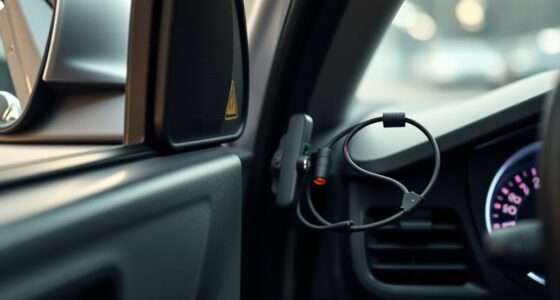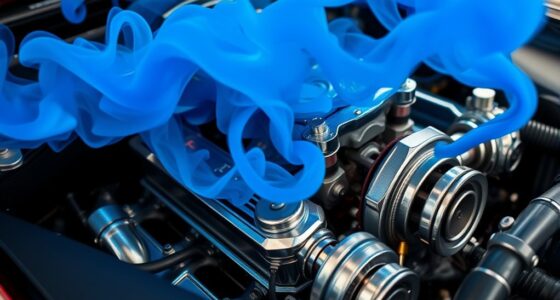If your Ford Transit won’t start, start by checking the battery’s charge and connections for corrosion or looseness. Inspect fuses, relays, and the starter motor for faults or damage. For diesel models, ensure fuel filters and pump relays are functioning properly. Also, test the ignition switch and security system for issues. If these quick checks don’t resolve it, more detailed troubleshooting can uncover the exact cause and get your van moving again.
Key Takeaways
- Check the battery’s voltage and terminals for corrosion to ensure reliable electrical flow.
- Inspect the starter motor, relay, and wiring for signs of wear, damage, or faulty connections.
- Verify the ignition switch and security system for faults or immobilizer issues preventing engine start.
- Test fuel pump fuse, relay, and fuel filters, especially in diesel models, for proper fuel delivery.
- Listen for clicking sounds when turning the key, indicating relay or starter motor function problems.
Diagnosing Ignition Switch Problems
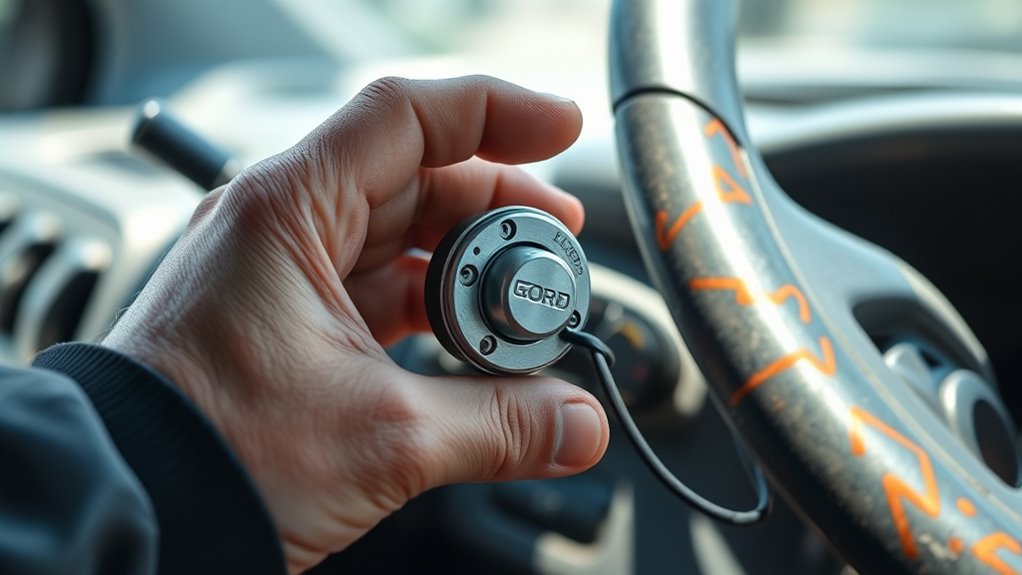
Diagnosing ignition switch problems in your Ford Transit begins with paying close attention to how the vehicle responds when you turn the key. If the engine fails to start or stalls shortly after, it could be a sign of ignition switch issues. Wiggle the key while the engine is in park—if the engine dies or dashboard lights flicker, the switch might be faulty. Listen for clicking relays; their absence can point to switch failure. Check if turning the key to the second stage briefly illuminates dash lights then quickly turns them off. Also, notice if the starter motor remains silent despite turning the key. Worn contacts inside the ignition switch can cause intermittent power loss, so these signs help you narrow down the problem before considering replacement. Additionally, understanding retail hours can help you plan visits to a mechanic or parts store for replacements or repairs.
Checking Battery Health and Electrical Connections

Ensuring your Ford Transit’s battery is in good condition is essential for reliable starting. First, test your battery with a proper analyzer, connecting directly to the terminals without using starting aids, and select the correct battery type for accurate results. Check the state of charge and internal resistance; a “Recharge” or “Fair” reading indicates the battery needs attention. Use refractometers to verify individual cell acid levels, as a bad cell can compromise the entire battery. Inspect terminals for tightness, corrosion, and cleanliness—clean with appropriate solutions if needed. Make sure cables and clamps are intact, free from damage, and connected correctly (red to positive, black to negative). Proper electrical connections guarantee your battery’s health and prevent starting issues. Additionally, battery maintenance plays a crucial role in prolonging battery life and ensuring consistent vehicle performance. Regularly inspecting and maintaining these components can prevent unexpected breakdowns, reduce the risk of battery failure, and save you time and money.
Inspecting Fuses and Relays for Power Flow
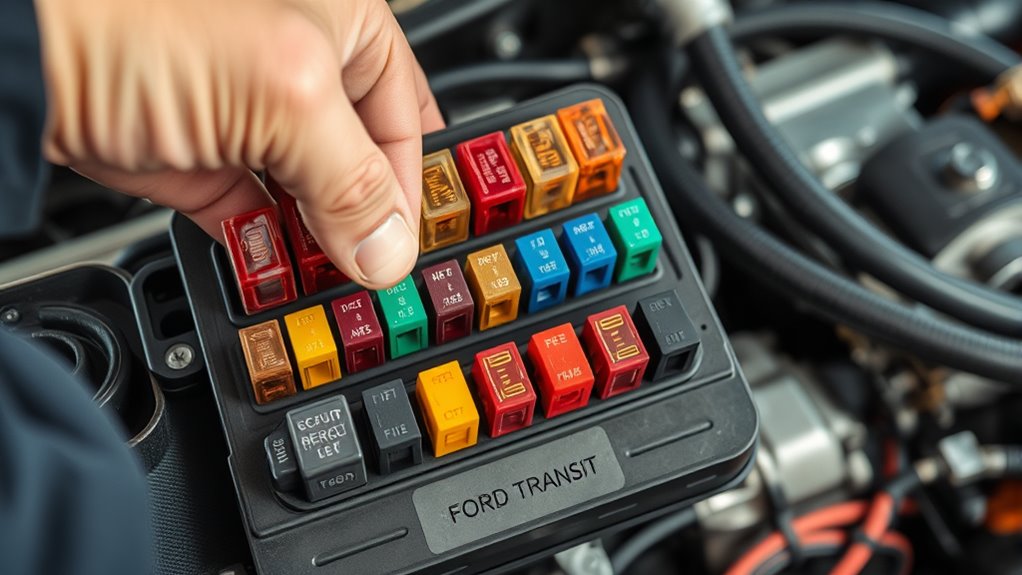
Have you checked the fuses and relays responsible for your Ford Transit’s starting system? Start by locating the multiple fuse boxes: under the hood, behind trim panels, under the driver’s seat, and inside the passenger compartment. Focus on the engine compartment fuse box, which contains relays and fuses linked to ignition and the starter. Visually inspect each fuse for melted or broken filaments. Use a multimeter set to continuity to confirm if fuses are intact. For relays, swap them with known good ones of the same type or test their coil resistance and contacts on a bench. Check relay socket terminals for corrosion or loose connections. During ignition, measure voltage at relay input and output terminals to ensure proper power flow during start attempts. Proper maintenance practices can help prevent issues with fuse and relay failures. Additionally, understanding electrical system fundamentals can assist in diagnosing more complex starting problems.
Troubleshooting Fuel Delivery and Glow Plugs in Diesel Models

Fuel delivery issues are a common reason your Ford Transit diesel might not start, and troubleshooting them requires a systematic approach. First, check the fuel pump fuse and verify it’s seated properly; corrosion or poor connections can disrupt power. Test voltage at the fuse and confirm relay operation, especially the brown and gray wires supplying power and output. Inspect fuel pump control modules and relays near the tank for proper voltage and ground continuity. If the fuel pump isn’t running or makes no noise, it could be faulty or clogged. Consider fuel filter clogging as well—replacing it can restore pressure. For older pumps, like Bosch VP44 types, failure after high mileage is typical. When in doubt, an extensive diagnosis helps identify whether the pump, wiring, or relay is the root cause. Additionally, performance kits and ECU tuning options for diesel models can sometimes influence starting performance and overall fuel system efficiency.
Assessing the Starter Motor and Related Components
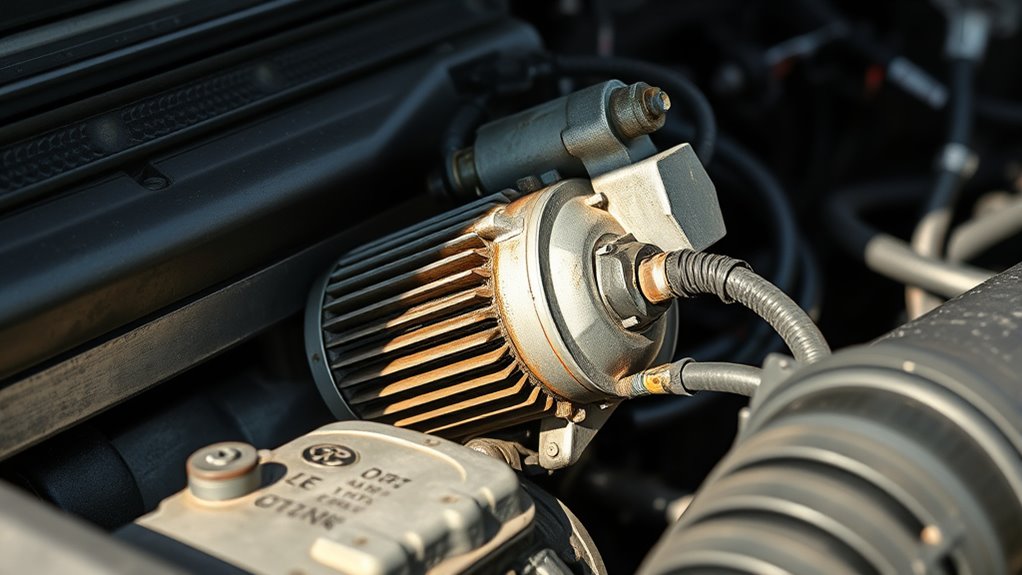
To diagnose starter motor issues, start by testing its performance with a bench test to check for sluggishness or smoke, which indicate internal problems. Next, verify the relay and solenoid functions by listening for clicks and performing electrical checks with a multimeter to identify faults. Finally, assess the wiring, connections, and cranking behavior to pinpoint whether electrical or mechanical components are causing the starting problem. Additionally, consider juice cleansing techniques to support overall health during troubleshooting, as proper hydration can improve focus and energy levels. Understanding starter motor functionality and common failure signs can also help in diagnosing issues more accurately. Regularly inspecting electrical connections can prevent corrosion and ensure consistent performance.
Starter Motor Testing
Evaluating the starter motor and its related components is a critical step in diagnosing starting issues in a Ford Transit. Begin with a visual inspection for signs of wear, oil contamination, or corrosion on terminals, which can block current flow. Check that the starter gear moves smoothly and pulls forward easily without binding, and ensure it rotates freely without resistance, indicating internal health. Cleanliness matters—oil or diesel contamination can cause sluggish operation. For bench testing, remove the starter and connect it to a 12V battery with jumper cables. Activate the solenoid directly, listening for smooth engagement and retracting gear. Observe for irregular noises or slow spinning, which signal internal problems. Always verify proper grounding and avoid prolonged testing to prevent damage. Additionally, inspecting the starter relay can help identify electrical issues that prevent the motor from activating properly. Familiarity with regional legal resources can also assist in obtaining professional diagnostics if needed.
Relay and Solenoid Checks
Checking the relay and solenoid is vital when diagnosing starting problems on your Ford Transit because they control the flow of electrical current to the starter motor. The relay acts as a switch, amplifying the low current from your ignition switch to deliver high current to the starter solenoid. When you turn the key, it sends a signal to the relay, which then energizes the solenoid to engage the starter motor and crank the engine. To test them, you can use jumper wires to bypass the relay—if the starter engages, the relay might be faulty. Also, check for voltage at the relay terminals and inspect for blown fuses. Corroded terminals, loose wiring, or internal relay damage can prevent proper operation, so thorough inspection is essential for accurate diagnosis. Additionally, testing the relay with a multimeter can help confirm whether it’s functioning correctly or needs replacement. Ensuring the starter circuit components are in good condition is crucial for reliable engine starting. Regular inspection of the relay and solenoid can also help prevent unexpected starting issues, and understanding the electrical system can aid in troubleshooting more complex problems.
Diagnosing Cranking Issues
When diagnosing cranking issues in your Ford Transit, it’s essential to examine the starter motor and its internal components for signs of wear or damage. Check for worn brushes, which can become gummed up by diesel leaks, or damaged commutators from repeated failed starts. Internal bearings and bushings may be worn, causing squealing or grinding noises. Also, inspect the mechanical drive gear (Bendix) and flywheel teeth for damage or sticking. To help identify issues, review the following:
| Component | Common Symptoms/Problems |
|---|---|
| Brushes & Commutator | Wear, gumming, or damage causing poor contact |
| Bearings & Bushings | Noisy operation, squealing, grinding |
| Mechanical Drive Gear | Damage, jamming, or misalignment with flywheel teeth |
Proper assessment pinpoints whether the starter itself or related components need repair. Additionally, poor electrical connections at the top of the solenoid can often mimic starter motor issues, so ensuring clean and tight connections is crucial for accurate diagnosis. Regular inspection of the electrical system can help prevent recurring problems that lead to starter failure.
Verifying Key, Security, and Immobilizer Systems

Have you verified that your key, security system, and immobilizer are functioning correctly? Check for a warning message like “Immobiliser Active” on your dashboard. If you see this, the immobilizer system might be preventing your engine from starting. Common causes include a damaged transponder chip or a faulty antenna ring around the ignition barrel. The antenna detects and transmits the key’s signal; if it fails, communication stops, disabling the fuel pump and ignition. You can test this by replacing the antenna ring, which costs around £30 and can be installed by a local garage. If the immobilizer is active, reprogramming or resetting the system might be necessary, often requiring professional tools or assistance from a qualified locksmith or Ford dealer. Hyundai Tuning offers insights into vehicle electronics and security systems that can assist in diagnosing immobilizer issues more effectively. Having up-to-date diagnostic tools can help identify and resolve immobilizer issues more efficiently. Additionally, understanding vehicle security systems can help prevent false immobilizer triggers and ensure your vehicle starts reliably. Proper knowledge of security protocols can also reduce the risk of inadvertent immobilizer activation.
Quick Tips for Common No-Start Symptoms

If your Ford Transit won’t start, start by inspecting the basics for quick fixes. Check the battery voltage with a multimeter— a dead or weak battery is the most common cause. Clean corroded terminals to guarantee good electrical flow. Listen for clicking sounds when turning the key; no noise might point to a faulty starter motor or relay. Test the starter relay by swapping it with a known good one. Verify electrical connections and grounding points near the starter. If the engine cranks but doesn’t fire, suspect ignition switch issues or fuel system problems like air in the lines or a blocked fuel filter. Also, inspect relevant fuses and relays for damage or corrosion, replacing or cleaning as needed to restore proper power flow. Additionally, understanding Kia Tuning options can help optimize your vehicle’s performance and troubleshoot related issues. Exploring remote hackathons can also provide innovative solutions and tools for vehicle diagnostics and customizations. To improve your vehicle’s reliability, consider Mazda Tuning techniques to enhance overall engine performance and responsiveness.
Frequently Asked Questions
How Can I Tell if My Ignition Switch Is Faulty?
You can tell if your ignition switch is faulty if your dashboard lights flicker or fail to turn on, and you experience intermittent power loss when turning the key. Wiggling the key might cause the engine to stall or prevent it from starting. Additionally, if accessories cut out or the engine stalls unexpectedly during driving, these are signs. Try turning the key and observing if electrical components behave erratically; these issues point to a faulty switch.
What Are Signs of a Failing Starter Relay?
You’ll notice a failing starter relay if you hear a repeated clicking noise when turning the key, but the engine doesn’t crank. Sometimes, the relay stays engaged or keeps running after you turn off the ignition. You might also see dashboard warning lights flicker or come on. Corroded wiring, loose connections, or inconsistent electrical flow can cause these symptoms, and testing the relay with a multimeter can confirm if it’s failing.
How Do I Reset the Vehicle’s Security System?
Did you know that nearly 30% of vehicle security system resets are successful using simple methods? To reinitialize your Ford Transit’s security system, start by turning the ignition to the “on” position for 10-15 minutes, allowing the system to reset. Use your key to lock and unlock the door, or disconnect the battery for about 15 minutes as a last resort. Also, a compatible scan tool can help reprogram the modules if needed.
Can a Weak Battery Still Cause Starting Issues?
Yes, a weak battery can cause starting issues. When your battery lacks enough charge, it can’t provide the necessary power to turn the engine over efficiently. You might notice slow cranking, clicking sounds, or no response at all. Cold weather makes this worse. To fix this, test your battery’s capacity, clean the terminals, or replace the battery if it’s failing. Keeping your battery healthy prevents these starting problems.
What Should I Do if My Diesel Engine Won’T Bleed Fuel?
If your diesel engine won’t bleed fuel, start by filling the new filter with clean diesel to reduce trapped air. For example, when I replaced a filter, I used the manual primer to push fuel through the system. Loosen the bleed screw or fuel line at the injectors and crank the engine briefly to expel air. Repeat until fuel flows steadily, then tighten connections and start your engine.
Conclusion
If your Ford Transit won’t start, don’t get discouraged. Nearly 80% of no-start issues are caused by simple electrical or fuel system problems you can check yourself. By following these quick tips, you might identify the culprit faster and save time and money. Remember, regular maintenance can prevent many of these issues. Stay vigilant, and if you’re still stuck, don’t hesitate to seek professional help—your Transit is worth it!




